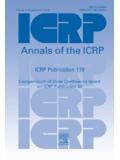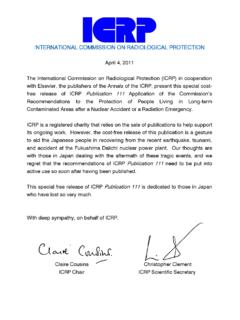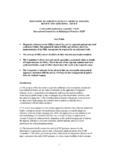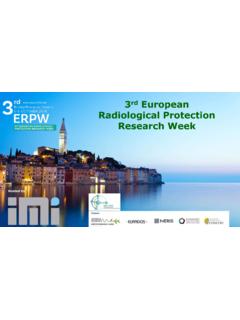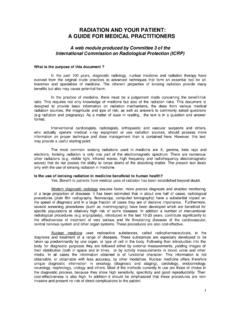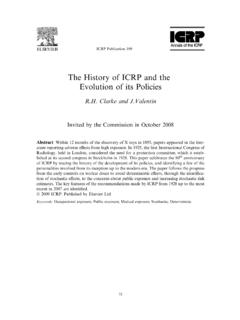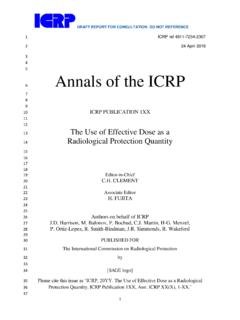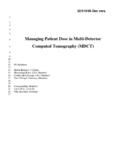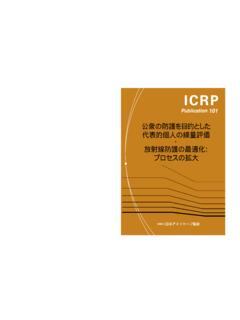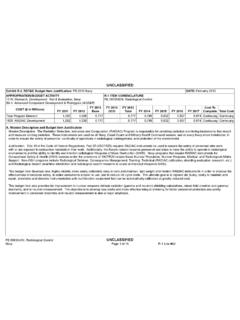Transcription of ICRP Symposium on Radiological Protection …
1 icrp Symposium on Radiological Protection DosimetryTokyo February 18th, 2016M. Zankla, J. Beckera, Eckermanb, Bolchc, R. Behrensda Helmholtz Zentrum M nchen, Neuherberg, Germanyb Oak Ridge National Laboratory, Oak Ridge, TN, USAc University of Florida, Gainesville, FL, USAd Physikalisch-Technische Bundesanstalt, Braunschweig, Germany Dose quantities for Radiological Protection Calculation of conversion coefficients Construction of voxel phantoms Comparison of stylized and voxel phantoms icrp Reference Computational Phantoms (voxel-type) Limitations due to voxel resolution Detailed eye model (stylized) Applications and conceptual limitations of thereference computational phantoms23 Operational quantities Ambient dose equivalent, H*(d) Directional dose equivalent, H (d, ) Personal dose equivalent, Hp(d)
2 Protection quantities Organ absorbed dose, DT Organ equivalent dose, HT Effective dose, EMonitored quantitiesInstrument responsesCalculated using wR, wT,and anthropomorphic phantomsCalculated using Q(L)and selected phantoms (sphere, slab, rod, ..)ComparisonPhysical quantities Fluence, Kerma, K Absorbed dose, D As long as the monitored quantities are belowcertain levels, compliance of the protectionquantities with the legal dose limits is assured. Conversion coefficients provide relationshipsbetween operational and Protection quantities , thus allowing organ and effective doses to beassessed in by calibration and calculation4 Stylized models of the human body have been used for decades5 Model of the radiationsource Model of the body Physical models of radiation interactions energy depositionsPastRecently6 Original CT slice Grey values: absorption propertiesImage processing softwareSegmentedsliceColours.
3 Identification numbers assigned to individual organs7 Data per slice arranged in columns and rows of pictureelements (pixel)IreneVisibleHumanGolemStack of slices 3D array of volume elements (voxel)163 cm51 kg180 cm102 kg176 cm69 kg8 Made of image data of real patients (millions of voxels) by applying segmentation techniques 60-140 different organs and tissues, even small ones Realistic anatomy (improvement compared to the stylized phantoms) and this has a dosimetric impact Dose differences between seven individual voxelmodels mostly < 30% (60-200 keV); in singlecases up to 100% and more Dose values for stylized phantoms partly outside these ranges Reason: unrealistic geometry Organs located too shallowly beneath the skin: stomach, spleen, kidneys Circumference of trunk too flat (elliptical) Constant trunk diameter from neck down to bottom oftrunk1011 icrp has specified their main characteristics:Reference masses for 56 organs, organ groups, and tissues12 Select segmented voxel models of male andfemale individual whose bodyheightandmass closely resembletheICRP 89 reference values Golem :176 cm,69 kg(176 cm,73 kg) Laura.
4 167 cm,59 kg(163 cm, 60 kg)Modifythese segmented voxel models in several stepsGolemLauraMethod of constructionFor the first time, the icrp and ICRU haveadopted reference computationalphantoms as representations of theReference Male and Reference scaling Use body height to scale voxel height Use skeleton volume to scale voxel in-plane organ volume modifications Dedicated software tool VolumeChange modifications (blood, lymphatic nodes, movement of arms, adjustment of whole-body mass byadding adipose tissue, inclusion of skin at top and bottom) of the skeleton 19 bones (bone groups) Subdivision in cortical shell spongiosa medullary cavity (long bones)14 Male176 cm, 73 million voxelsVoxel size: mm3 Female163 cm, 60 million voxelsVoxel size: mm3140 Organ identificationnumbers53 different tissue types15 Extrathoracic airways, trachea: one voxel layer does not mirror their small dimensions (thickness in the range ofmicrometres) but: locates them at correct anatomical position Bronchi only larger diameters no proper tree structure Bronchioles: homogeneous lung tissue Skin: one voxel layer Cartilage: only small amount segmented Gall bladder: not enough wall voxels to enwind the contents Eye lenses.
5 Not properly covered by correct amount of overlyingtissue Adipose tissue used to fill up the whole body mass meets the reference values of icrp Publication 89 only approximately16 Based on work byCharles and Brown 1975 Recent epidemiological data on cataract induction have led to increasinginterest in doses to the eye lens which is not well represented in the voxel-type reference computational detailed eye model is being used for simulations of externalirradiation with weakly penetrating radiation types and These phantoms are theofficial computational modelsrepresenting theICRP Reference Male andReference Female. They are based on computed tomographic data of real persons. They have organ masses of reference values, but they have still individual organ topology reflecting the tomographic data used in theirconstruction.
6 Both modelscannot represent any real individual. They are defined to enable calculations of the Protection quantitiesorgan and tissueequivalent dose andeffective dose. For weakly penetrating radiations, a separate mathematical phantom ofthe eye with detailed definition of theeye lenshas been used in additionto the voxel reference phantoms. Further work addressing limitations of the reference computationalphantoms due to voxel resolution will be presented in the next talk .. you very much for your attention!
